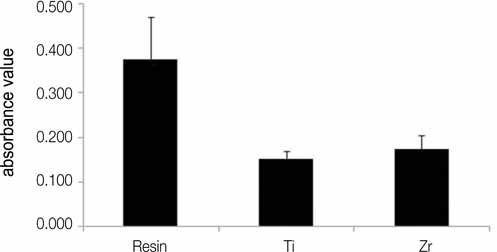J Adv Prosthodont.
2011 Jun;3(2):81-84. 10.4047/jap.2011.3.2.81.
Initial bacterial adhesion on resin, titanium and zirconia in vitro
- Affiliations
-
- 1Department of Prosthodontics and Dental Research Center, School of Dentistry, Seoul National University, Seoul, Korea. proshan@snu.ac.kr
- 2Interdisciplinary Program for Bioengineering, Seoul National University, Seoul, Korea.
- 3Department of Advanced Material Engineering, Sejong University, Seoul, Korea.
- KMID: 1975081
- DOI: http://doi.org/10.4047/jap.2011.3.2.81
Abstract
- PURPOSE
The aim of this in vitro study was to investigate the adhesion of initial colonizer, Streptococcus sanguis, on resin, titanium and zirconia under the same surface polishing condition. MATERIALS AND METHODS: Specimens were prepared from Z-250, cp-Ti and 3Y-TZP and polished with 1 microm diamond paste. After coating with saliva, each specimen was incubated with Streptococcus sanguis. Scanning electron microscope, crystal violet staining and measurement of fluorescence intensity resulting from resazurin reduction were performed for quantifying the bacterial adhesion.
RESULTS
Surface of resin composite was significantly rougher than that of titanium and zirconia, although all tested specimens are classified as smooth. The resin specimens showed lower value of contact angle compared with titanium and zirconia specimens, and had hydrophilic surfaces. The result of scanning electron microscopy demonstrated that bound bacteria were more abundant on resin in comparison with titanium and zirconia. When total biofilm mass determined by crystal violet, absorbance value of resin was significantly higher than that of titanium or zirconia. The result of relative fluorescence intensities also demonstrated that the highest fluorescence intensity was found on the surface of resin. Absorbance value and fluorescence intensity on titanium was not significantly different from those on zirconia.
CONCLUSION
Resin specimens showed the roughest surface and have a significantly higher susceptibility to adhere Streptococcus sanguis than titanium and zirconia when surfaces of each specimen were polished under same condition. There was no significant difference in bacteria adhesion between titanium and zirconia in vitro.
MeSH Terms
Figure
Reference
-
1. Filoche S, Wong L, Sissons CH. Oral biofilms: emerging concepts in microbial ecology. J Dent Res. 2010. 89:8–18.2. Scheie AA, Petersen FC. The biofilm concept: consequences for future prophylaxis of oral diseases? Crit Rev Oral Biol Med. 2004. 15:4–12.3. Ono M, Nikaido T, Ikeda M, Imai S, Hanada N, Tagami J, Matin K. Surface properties of resin composite materials relative to biofilm formation. Dent Mater J. 2007. 26:613–622.4. Hojo K, Nagaoka S, Ohshima T, Maeda N. Bacterial interactions in dental biofilm development. J Dent Res. 2009. 88:982–990.5. Li J, Helmerhorst EJ, Leone CW, Troxler RF, Yaskell T, Haffajee AD, Socransky SS, Oppenheim FG. Identification of early microbial colonizers in human dental biofilm. J Appl Microbiol. 2004. 97:1311–1318.6. Teughels W, Van Assche N, Sliepen I, Quirynen M. Effect of material characteristics and/or surface topography on biofilm development. Clin Oral Implants Res. 2006. 17:68–81.7. Subramani K, Jung RE, Molenberg A, Hammerle CH. Biofilm on dental implants: a review of the literature. Int J Oral Maxillofac Implants. 2009. 24:616–626.8. Busscher HJ, Rinastiti M, Siswomihardjo W, van der Mei HC. Biofilm formation on dental restorative and implant materials. J Dent Res. 2010. 89:657–665.9. Scarano A, Piattelli M, Caputi S, Favero GA, Piattelli A. Bacterial adhesion on commercially pure titanium and zirconium oxide disks: an in vivo human study. J Periodontol. 2004. 75:292–296.10. Auschill TM, Arweiler NB, Brecx M, Reich E, Sculean A, Netuschil L. The effect of dental restorative materials on dental biofilm. Eur J Oral Sci. 2002. 110:48–53.11. Hahnel S, Rosentritt M, Handel G, Bürgers R. Surface characterization of dental ceramics and initial streptococcal adhesion in vitro. Dent Mater. 2009. 25:969–975.12. Manicone PF, Rossi Iommetti P, Raffaelli L. An overview of zirconia ceramics: basic properties and clinical applications. J Dent. 2007. 35:819–826.13. Ikeda M, Matin K, Nikaido T, Foxton RM, Tagami J. Effect of surface characteristics on adherence of S. mutans biofilms to indirect resin composites. Dent Mater J. 2007. 26:915–923.14. Pihlstrom BL, Michalowicz BS, Johnson NW. Periodontal diseases. Lancet. 2005. 366:1809–1820.15. Quirynen M, Bollen CM. The influence of surface roughness and surface-free energy on supra- and subgingival plaque formation in man. A review of the literature. J Clin Periodontol. 1995. 22:1–14.16. Bollen CM, Lambrechts P, Quirynen M. Comparison of surface roughness of oral hard materials to the threshold surface roughness for bacterial plaque retention: a review of the literature. Dent Mater. 1997. 13:258–269.17. Al-Ahmad A, Wiedmann-Al-Ahmad M, Faust J, Bächle M, Follo M, Wolkewitz M, Hannig C, Hellwig E, Carvalho C, Kohal R. Biofilm formation and composition on different implant materials in vivo. J Biomed Mater Res B Appl Biomater. 2010. 95:101–109.18. Puckett SD, Taylor E, Raimondo T, Webster TJ. The relationship between the nanostructure of titanium surfaces and bacterial attachment. Biomaterials. 2010. 31:706–713.
- Full Text Links
- Actions
-
Cited
- CITED
-
- Close
- Share
- Similar articles
-
- A review of biocompatibility of zirconia: In vitro experiment
- Zirconia Abutment Fracture in the Anterior Region: Case Series
- Comparison of marginal and internal fit of zirconia abutments with titanium abutments in internal hexagonal implants
- Comparison of biofilm on titanium and zirconia surfaces: in vivo study
- Evaluation of reverse torque value of abutment screws on CAD/CAM custom-made implant abutments




